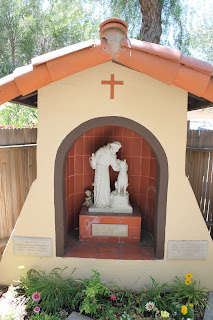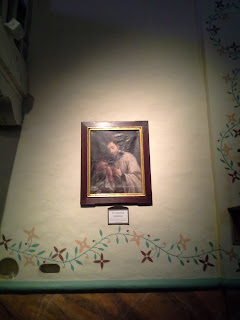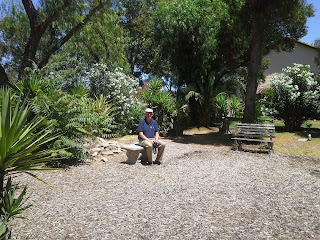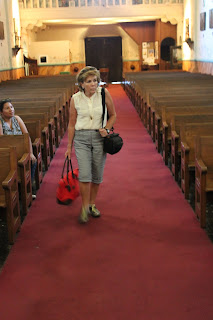As we departed Santa Barbara after a delightful 2 day sojourn, and headed north, we heeded the recommendation of one of our friends from California: "Don't miss Solvang! It's like a small town of Denmark!" Trying to live an authentic "Danish experience in California" wasn't something I fancied, but my curiosity got the best of me.
In 1911, three Danish educators set out on a
mission of their own: setting up a Danish village
in California, on 9,000 acres of old Rancho San
Carlos, which had been part of the original
Mission Santa Inés. Solvang, population 5000,
means "Sunny Meadow". Mission Santa Ines is
only a few hundred feet away.
Solvang is a 33 mile or 45 minute pleasant drive from Santa Barbara, along route 154, which took us away from route 1, and consequently from those breathtaking views of the Pacific Ocean. Instead of the surf of the beach waves crashing over the breakers, Route 154 took us down a path of California that we rarely view in movies. Here is the backcountry: farms, lakes, ranches. Hardworking friendly people.
The landscape of the central garden of Mission
Santa Ines was laid out by the Irish Franciscan
Capuchins with a hedge in the form of a giant
Celtic Cross, with the Fountain as the center
of the Cross.
So when our GPS indicated that downtown Solvang was just a left turn away from us at the traffic light that laid only a few hundred feet ahead, I noticed out of the corner of my eye a driveway and sign: "Mission Santa Inés".
The Irish Franciscan Capuchins were one more
of a series of landlords of Mission Santa Ines,
takingcharge when Father Buckler retired
in 1924,
Although this stopover was not part of that day's agenda, the temptation was too much. So we made a U-turn and drove into the Mission parking lot.
Mission Santa Ines was founded as the 19th of the 21 Franciscan Missions of Alta California, established by Father Estévan Tapia, in 1804.
Santa Inés was never a very densely populated area, at in 1815, its year of greatest success, it only had less than 768 inhabitants, mostly Chumash.
In 1824, Mission Santa Inés suffered a revolt, has a soldier hit a visiting Chumash native from the neighboring Mission La Purisima. The soldier was a corporal whose name was Cota. the Indian retorted that the King of Spain would never permit the soldiers to strike the natives. Cota responded that he no longer was accountable to any "King" other than his general.
The history of the uprising of the Chumash had a heroin, Pasquala. She was from the nearby Tulares Tribe. Her family would use the Mission as a resting spot on their trips down to the seaside in search of fish and shells. On one of those stopover, Pasquala became very sick. The personnel at the Mission took care of Pasquala, until she recovered. Pasquala and her family were so grateful that they became Christians, and her father stayed on in the Mission to work in the vineyards.

This small plot in the central atrium of
Mission Santa Ines marks the place where the
corner stone of the first center of higher learning
in the State of California, the College of
Our Lady of Refuge, a Catholic Seminary.
Warriors from her tribe came and killed her father, and took her away by force. When she realized that the people of her tribe were preparing to attack and destroy Mission Santa Ines, she left her camp secretly,and ran for days. When she arrived at the Mission, Pasquala started shouting: "Padre, Padre! War! War!"
Padre Francisco was a trained soldier before become a Franciscan, so he knew how to prepare the Mission for the attack. The Tulares appeared several days later with their bows and arrows and attacked the church from the back and set it on fire. But the Mission was prepared and set back the attacking Tulares, that turned and fled. The fire was put out and the Mission saved. However Pasquala, weak from so much fatigue, died a few days later.She was buried here at the Mission.
The Indians started by burning down the soldier quarters, and the soldiers responded by burning down the natives dwelling. The flames spread to the church, and the Chumash went over to fight the fire, and the Indian boys went running into the Sacristy to save the vestments.
In this corner of the Mission
courtyard is this monument
honoring Saint Francis of Assisi
for his prodigious handling of
the vicious wolf that terrorized
the population of nearby (to
Assisi) Gubbio.
Saint Francis of Assisi never tired of preaching,
but at times, people tired of listening to him,
which frustrated him so, that he would preach to
the birds in the trees, the fish in the streams and
even a ravaging wolf that was terrorizing
Gubbio, until he allegedly told the wolf not to
attack the sheep, and the townspeople to leave
leftovers at their doorsteps to feed the wolf.
This plaque in the garden is a complete map of
the 21 Franciscan Missions of Alta California,
with references to nearby modern cities.












































































